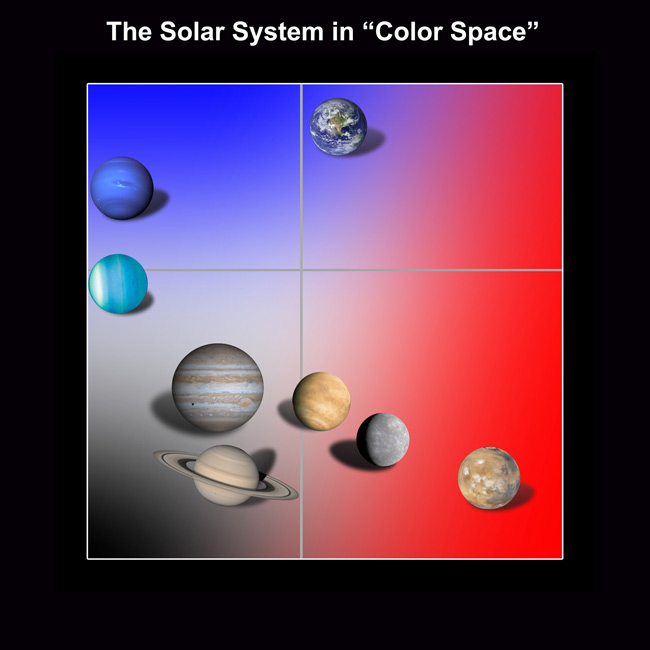Looking for Earth-like Alien Planets? Focus on the Blue Ones

Astronomers hunting for Earth-likealien worlds couldimprove their odds by zeroing in on planets that look blue from afar,just likeEarth, a new study suggests.
Researchers have devised a simple wayto distinguish betweenthe planets of our solar system based on color information alone. Earthinparticular stands out clearly among the other planets from space,researcherssaid, appearing much bluer than Mars, Venus, Mercury and the gasgiants. [Diagramof planet colors.]
The finding could aid the search forlife beyond Earth,helping astronomers focus their attentions on the worlds most likely toharborlife, researchers said.
"Eventually, as telescopes getbigger, there will bethe light-gathering power to look at the colors of planets around otherstars," said study leader Lucy McFadden of NASA's Goddard Space FlightCenter in Greenbelt, Md. "Their colors will tell us which ones to studyinmore detail."
A rainbow of planets
McFadden and her colleagues used newcolor information aboutEarth, the moon and Mars gathered by NASA's Deep Impact spacecraft asit zoomedthrough space en route to a close encounter with CometHartley 2 on Nov. 4.
Deep Impact's instruments eyed thesecelestial bodiesthrough a variety of filters, sampling light at different portions ofthespectrum. The relative amounts of light passing through variedsignificantly,providing a kind of color fingerprint.
Get the Space.com Newsletter
Breaking space news, the latest updates on rocket launches, skywatching events and more!
The team added to Deep Impact'sobservations existing colorinformation about Mercury, Venus, Jupiter, Saturn, Uranus, Neptune andSaturn'slargest moon, Titan. The team found that color data from threedifferentfilters ? one in green light, one in red and one in blue ? separatedtheplanets out from each other very effectively.
The researchers drew up a chart thatclustered planets intogroups based on similarities in the wavelengths of sunlight that theirsurfacesand atmospheres reflect. The gas giants Jupiter and Saturn huddled inonecorner, Uranus and Neptune in a different one. The rocky inner planetsMars,Venus and Mercury clustered off in their own corner of color space.
But Earth did not cluster with anyother planets, standingby itself in one part of the chart. Its uniqueness traces to twofactors,researchers said: the scattering of blue light by its atmosphere andthe factthat it does not absorb much infrared light.
Earth's air is low ininfrared-absorbing gases like methaneand ammonia, compared to the gas giant planets Jupiter and Saturn,according toresearchers.
"It is Earth's atmosphere thatdominates the colors of Earth,"said co-author Carolyn Crow, a grad student at UCLA. "It's thescatteringof light in the ultraviolet and the absence of absorption in theinfrared."
The team's study will be published inan upcoming issue ofthe Astrophysical Journal.
A colorfulfuture
Planets around other stars probablyexhibit a rainbow ofcolors every bit as diverse as those in our solar system. Astronomerscouldeventually apply the new study's findings, using the three-filterapproach to geta rough idea of what an exoplanet'ssurface and atmosphere might look like.
For example, if an alienplanet shows a similar color fingerprint to Earth's, it wouldnotnecessarily mean that the planet has the blue skies and vast oceans ofourhome. But it could tell astronomers to look at that planet moreclosely.
And that would be an important firststep toward makingsense of the colorful complexity of the 490-odd alien planets alreadydiscovered, and the scores more on the way, researchers said.
Astronomers have already directlyimaged a handfulof alien planets around distant stars, and this number shouldonly increaseas technology advances and scientists hone their techniques.
- Gallery:Strangest Alien Planets
- POLL:When Will Humanity Truly Find an Alien Earth?
- Determining500th Alien Planet Will Be a Tricky Task
Join our Space Forums to keep talking space on the latest missions, night sky and more! And if you have a news tip, correction or comment, let us know at: community@space.com.

Space.com is the premier source of space exploration, innovation and astronomy news, chronicling (and celebrating) humanity's ongoing expansion across the final frontier. Originally founded in 1999, Space.com is, and always has been, the passion of writers and editors who are space fans and also trained journalists. Our current news team consists of Editor-in-Chief Tariq Malik; Editor Hanneke Weitering, Senior Space Writer Mike Wall; Senior Writer Meghan Bartels; Senior Writer Chelsea Gohd, Senior Writer Tereza Pultarova and Staff Writer Alexander Cox, focusing on e-commerce. Senior Producer Steve Spaleta oversees our space videos, with Diana Whitcroft as our Social Media Editor.